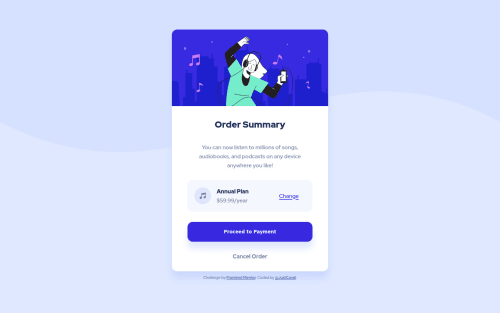Order Summary Component using Flexbox

Solution retrospective
Hi there, this is my first solution submitted on Frontend Mentor.
I used display:grid to achieve the pricing details layout and am wondering if this could be achieve with flexbox, and if so how?
Secondly, which would be the better solution to achieve the pricing details and best practices: grid or flexbox?
Any feedback would be greatly appreciated.
Thank you.
Please log in to post a comment
Log in with GitHubCommunity feedback
- @jomoke814
Congratulation on completing your 1st frontend challenge. To answer your question is Yes, You can use flexbox on pricing details to align them simply by grouping the music icon and annul plan together like so:
<div class="price"> <div class="section-price"> <img src="images/icon-music.svg" alt="music-icon"> <div> <h2>Annual Plan</h2> <p>$59.99/year</p> </div> </div> <p class="para-price">Change</p> </div> and you apply CSS flexbox styles .price { display: flex; border-radius: 10px; padding: 10px; gap: 50px; }Your second answer is that it comes down to personal preference and what a developer feels is easier for the given task. One way to think about the different uses of Grid and Flexbox is to consider whether your design originates with the content, or from the overall layout. If starting with the content, and working from the most minor parts outwards, then a developer is using Content-First Design. This is an excellent opportunity to use Flexbox because of the flexibility it provides in manipulating code in one dimension - along either rows or columns. If, however, a developer is given a specific overall layout to adhere to and needs explicit placement of elements in two dimensions, using both rows and columns, then Grid would be much better suited. For more about flexbox and grid read this article: https://webdesign.tutsplus.com/articles/flexbox-vs-css-grid-which-should-you-use--cms-30184
Marked as helpful
Join our Discord community
Join thousands of Frontend Mentor community members taking the challenges, sharing resources, helping each other, and chatting about all things front-end!
Join our Discord